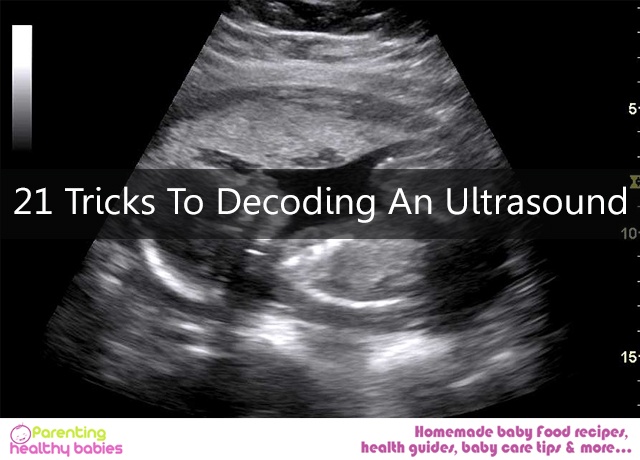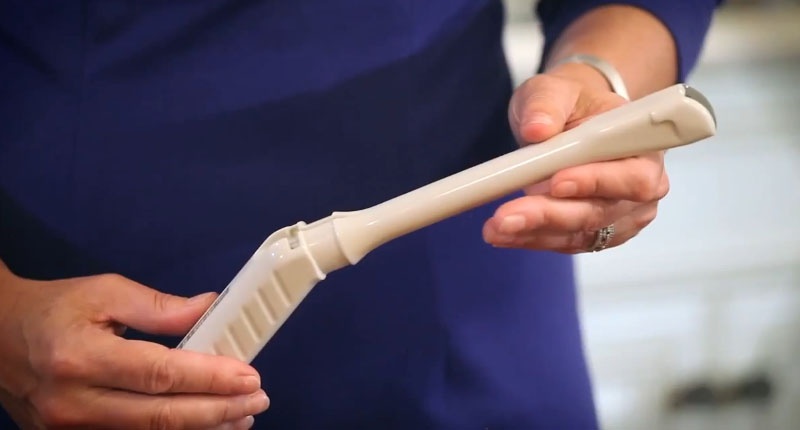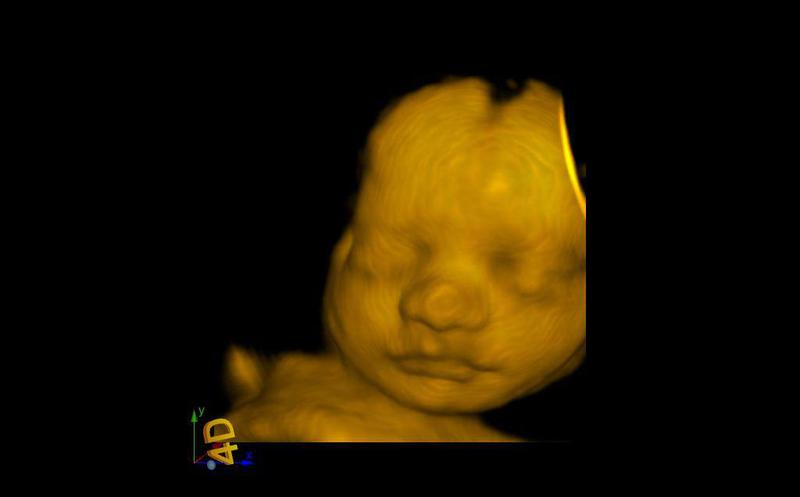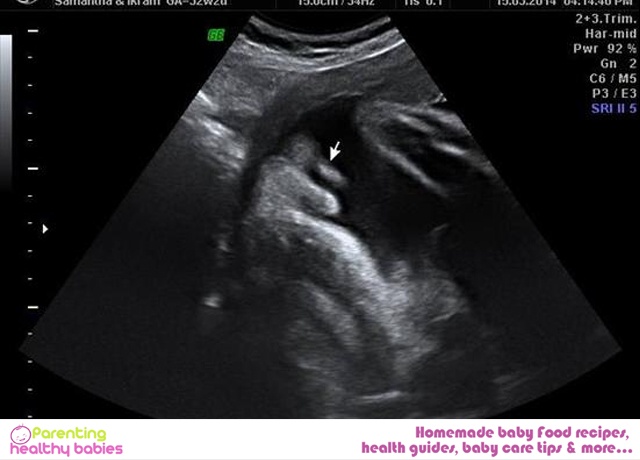Becoming pregnant, that too for the first time, is definitely a wonderful feeling. You must be excited to spill the beans to your extended family and adorn the new title! While you might be aware of the symptoms and action points by now, you will have to undergo a detailed ultrasound test to determine certain factors about the foetus. Most women, during the ultrasound find it difficult to communicate effectively with the sonographer due to various reasons like being shy, the fear of sounding silly, forgetting what to say at the right moment, and so on. However, you must be able to decode the ultrasound, with the help of your doctor, to get a better understanding of what’s happening inside your womb!
Read More: What Should I Expect on My First Baby Ultrasound?
Here are some smart tips to decode your ultrasound:
21 Ways to Decode Ultrasound
Know how it works
Ultrasound machines used now-a-days are called the real time scanners. The wand like object placed on your abdomen is called the transducer. This transducer projects high frequency sound waves in the abdomen. These waves ‘bounce’ off the internal organs and are collected back by the transducer. These bounced waves create an image which can be seen on the monitor.
The sticky thing that the health care profesional pours on the abdomen is called the gel. It allows the waves to pass into the abdomen without diverging into nearby air.
3-D and 4-D ultrasound scans also work on the same principle. In the 3-D scan, the ‘image’ is taken from many angles and then merged together to give a 3-D view.
A 4-D scan, also reffered to as dynamic 3-D scan, is a sequence of many 3-D scans in quick succession which gives an impression of a video.
As waves travel faster and straighter in a liquid medium, the doctor may advice you to keep your bladder full before the first trimester scans. It is also advisable to wear a two-piece garment for easy and stress free scans.
Check the statistics
When you look at the screen, you don’t just get a picture of the foetus, but you also get a statistical breakup of the details. The statistics are located on the top of the screen. They mainly consist of a list mentioning your name, the doctor’s name, the date and time of can, the category of scan, and the general observation.
The general information along with some abbreviations that may be used are:
IUGR: Intra Uterine Growth Rate. This depicts the current growth rate of the fetus.
CRL- Crown Rump Length. This is the length of the fetus. It is used to determine the expected date of delivery and the proper growth of the fetus.
BPD: Biparietal Diameter. It is the diameter between the two sides of the head. It is usually measured after 13 weeks and should be approx 9.5 cm. A far greater BPD may indicate hydrocephalus.
FL- Femur Length. It indicates the normal growth of the fetus and may be used to rule out certain bone deformities. It is measured after 14 weeks. The normal value is approx 1.5 cm at 14 weeks which increases to about 7.8 cm at term.
AC: Abdominal Circumference. It is used as a measure of fetal health. If the abdominal circumference is lower than the normal, it may indicate that the baby is not recieving enough nutrition. A much larger abdominal circumference indicates the risk of developing diabetes.
Pay attention to the first trimester scan
The first trimester scan is always a special one as you get to catch a glimpse of the foetus for the first time! This scan is generally done transvaginally and is mainly to confirm pregnancy and rule out ectopic pregnancies. You will see a small black circle in the centre of the larger grey circle.This black circle is the gestational sac. The tiny black bean that may be attached to the wall of the black circle is the embryo. If you see more than one black circle, it means you are carrying multiples!
Get an estimate of the due date
Now that your pregnancy is confirmed, the doctor will be able to provide you with an estimated due date. Early pregnancy scan is the best time to fix an EDD (estimated date of delivery). This is because the fetus grows at a constant rate of 1mm per day. This makes it easier for the gynaecologist to calculate the conception date. If you have already undergone the first trimester scan and have been confirmed pregnant, ask the doctor for a date to save.
Undergo a nuchal translucency scan
This ultrasound involves measuring the fluid at the back of your baby’s neck. It is done between 11 to 14 weeks because the fluid can first be clearly measured at 11 weeks and the fetal neck loses it’s translucency at 14 weeks. If there’s an abnormality, the fluid deposit will grow and show up. This test is done to detect Down’s syndrome, trisomy 18, heart valve defects and the presence or absence of nasal bone. The nuchal transparency test is a 2 part exam. The scan is the 1st part and has a diagnostic rate of 70% in itself. The other part is a simple blood test usec to measure a few hormones and enzymes. Both parts together have a 90% success rate in the detection of abnormalities. The doctor may also recommend some other tests like amniocentesis or chorionic villi examination in case of doubt.
Look forward to the second trimester scan
The scan that is scheduled at around 20 weeks into pregnancy will be your second trimester test. Remember to save the date and ask your doctor for an appointment if you haven’t already received one. After the nuchal translucency test, if everything goes fine, you are ready to move on to the next phase of tests!
Get an anatomy scan
This test involves measuring the foetus’ dimensions and testing for abnormalities in the physique based on whatever development has taken place till now. The scan lasts for about 20-40 minutes. It helps in determining if all organs are developing properly. You will be able to distinguish the kidney and stomach at this stage. Heart rate can be measured, baby’s fingers and toes can be counted. The development of brain can also be seen in the 20th week. Be sure to ask for a test to see that your baby is developing well, and to diagnose related problems in time.
Understand the black and white colours
Since an ultrasound consists of just two colours; black and white; with a tint of gray, it is vital to know which spot signifies what. This will make it easier for you to decode the picture that appears on the screen. The solids appear white and the liquids appear black due to difference in densities and the speed with which they bounce waves off.
The bones appear pearly white.
The cartilage appears a little darker than the bones, off white or greyish.
The amniotic fluid appears black.
Feel free to ask the doctor about the fine lines and patches that you come across. Decode the colours jointly. This way, you will get a better glimpse of the baby growing inside your womb!
Follow the pearl-like line
The first step to identifying the baby’s body is to follow the vertebrae, which is shown on the screen like a line of white pearls. Locating the spine makes it easier to go around the rest of the foetus’ body and view the same.
Now that you have successfully located the baby’s spine, try to move slightly away from that pearl line and view the limbs. Along with this, you can also catch a glimpse of the foetus’ nervous system, which is now running from its crown to its rump.
Understand the common visual effects
Ever wondered why some parts are brighter or darker than the others. Well, it is affected by the density of the organ, the position of the transducer probe, the angle at which the image is taken etc. The three major visual effects are:
Enhancement: the area may appear brighter due to excess of fluid or formation of cyst in the area.
Attenuation: Also called shadowing, this effect causes some structures to appear darker than they are.
Anisotropy: This effect is caused by the angle of the probe. Sometimes, a particular angle makes a field look brighter than it is. Positioning the probe to right angle of tendons can do the trick.
Understand the position of the foetus inside the womb
The spine and nervous system will help you decode the position in which the baby is lying inside your uterus. In case of doubts, ask your gynaecologist to point out the head of the foetus. Knowing this might help you prepare for the delivery pushes.
Watch out for the uterus line
While looking at the screen, try to locate the uterus line that’s white or gray around the edge of the womb. Many a time it happens that the baby is so tiny that you cannot view it properly! At least knowing the boundaries of the uterus will help you search in the right spot.
Read more: 5 Herbs That Strengthen Uterus
Look out for the foetus’ kidney
An oversized kidney can lead to serious consequences. Make sure that you know how big your child’s kidney is. Ask the doctor for the details and get specific medication if required.
Get a heart scan
This is a ultrasound which focuses chiefly on the heart. It is usually done along with doppler fetal monitoring. It uses high frequency waves bouncing off RBCs to measure the blood flow and pressure. A colour mapping is done to see the flow of blood. A uniform red and blue colour indicates blood flow towards and away from the tranducer. While a yellow colour indicates a turbulent flow.
This will determine the baby’s heart rate and the flow of blood throughout the body. If you see a uniform coloured body on the screen, it means a healthy heart.
Know the amniotic fluid texture
On the screen, the amniotic fluid will appear black just inside the larger grey outline of the uterus. You will see four pockets of fluid around the baby. The volume of the amniotic fluid is an important measurement. An increased amniotic fluid indicates gestational diabetes while a decreased amniotic fluid may result in premature delivery.
Get a glimpse of the placenta
The placenta is vital in providing blood and nutrition to the foetus and hence must be viewed properly during the scan. Placenta is viewed as a gray area inside your body. The sonographer can show it to you, if you stop feeling shy and ask!
Look at the shape of the foetus
Now that you’ve detected the spine, nervous system, and limbs of the foetus, take a better look at the screen during your next scan for viewing the foetus’ shape. This will give you a better feeling of your pregnancy and will encourage you to maintain a healthy diet.
Understand the sex
While you undergo the tests, make sure that you determine the baby’s sex by the time you are 20 weeks pregnant. The sonographer will understand from the clean pictures shot between the legs, whether the baby is a girl or a boy. For girls, it is harder to understand because there’ no protruding development. So, a hamburger’s sign consisting of 3 white lines is used. At times even boys develop their penises at later stages.
However, within 24 weeks, you will know the sex of the baby! Decoding this is the first step from which you will start shopping for the little one!
Read more: Week 24 of Pregnancy- Pregnancy Week by Week
View the baby’s face
By the time it is more than 20 weeks, the nasal bone and the earlobes of the baby will have developed well.
A 3-D scan is used to see if the baby has cleft lip and palate, polydactyl condition, clubbing of feet etc.You can Opt for a 4D scan to view the intricate details of your baby’s face and share the joy with your partner!
Read more: Week 20 of Pregnancy- Pregnancy Week by Week
Calculate the blood flow in your umbilical cord
The blood flow inside your umbilical cord is essential to understand the blood that the foetus is receiving and is circulating within its body. This is done by a uterine artery doppler scan. It measures the blood flow to the uterus and is helpful in predicting the pre-eclampsia condition.This also helps decode the reason behind being pregnant past your due date. However, a NST {non stress test} may be done to know the exact cause of overdue pregnancy.
Calculate the length of the foetus
The length of the foetus is generally calculated from the crown to the toe after it has developed its major parts. Knowing the length helps you and your therapist analyse the category of Lamaze exercises that you should opt for.
Keeping a watch on these factors while going for an ultrasound scan can help you decode the metrics and comprehend better, the growth quotient of your baby. Make sure that you coordinate with your gynaecologist and get the best out of every session that you attend. And, make sure that you ask your doctor for all the processes to be followed, now that you know about them! After all, that’s why you rush to the clinic every now and then!
Hope this article was of help for all our parents!! Please share your comments/queries/tips with us and help us create a world full of Happy and Healthy Babies!!













